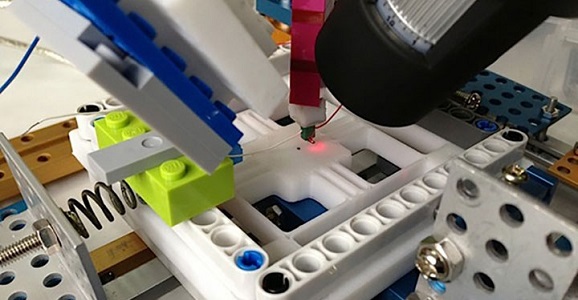Students Build Super Cheap Nanoscope Using Lego And Common Electronics
This article is more than 2 years old
 It’s hard to imagine a toy brand whose reputation has gotten stronger and more widespread than Lego. It used to just be a super-cool building block company that occasionally put out amazing collector sets; now its toy lines have expanded to cover TV shows, future films, and bestselling video games. But they’re still at their best when used in construction, and a group of PhD students from University College London (UCL), Tsinghua University, and Peking University have used Lego pieces to develop a low-cost Atomic Force Microscope (AFM), the first of its kind in the world.
It’s hard to imagine a toy brand whose reputation has gotten stronger and more widespread than Lego. It used to just be a super-cool building block company that occasionally put out amazing collector sets; now its toy lines have expanded to cover TV shows, future films, and bestselling video games. But they’re still at their best when used in construction, and a group of PhD students from University College London (UCL), Tsinghua University, and Peking University have used Lego pieces to develop a low-cost Atomic Force Microscope (AFM), the first of its kind in the world.
The Lego Foundation recently co-sponsored the LEGO2NANO competition, which teamed students up with scientists and device makers, challenging them to design a functioning AFM using only Lego blocks, Arduino microcontrollers, 3D-printed parts, and consumer electronics. An AFM, for those who don’t know, really puts the micro in microscope, as it is used to look at objects as small as a millionth of a millimeter. Not only was getting a cheaper AFM the eventual goal, but the event got a lot of Chinese high school students involved with the initiative and “was not only interdisciplinary,” said Professor Xiao Guio, Pro-Provost of UCL, “it also crossed the boundary between science and maker cultures.”
The winning team created their device in only five days, and won the Best Technical Design award for their efforts. While the AFMs that professionals use in their research tend to cost upwards of $100,000, the Lego AFM would only cost around $500 to make, and I’m sure that price would go down if these became produced on a mass scale. If it took a random team of people five days to reach such a goal, why aren’t there more group efforts going into these forms of discovery?
“Low-cost scientific instrumentation is not just useful in high schools; it can be a huge enabler for hospitals and clinics in developing countries, too,” says Gabriel Aeppli, director of the London Center for Nanotechnology at UCL. Quanshui Zheng, director of the Center for Nano and Micro Mechanics at Tsinghua Univerity, adds that “by setting such a hard challenge, we definitely pushed the envelope for hands-on learning, teamwork, and international cooperation. It also made the students think hard about the practical goals of their research.”
The outcome here is that these research tools will soon become an affordable option for areas that could never have afforded them before, inching global science forward in a big way.
And now, because you all asked for it, the outline of a thousand sci-fi films, as told in Lego. Doesn’t take a nanometer to see the genius here.












